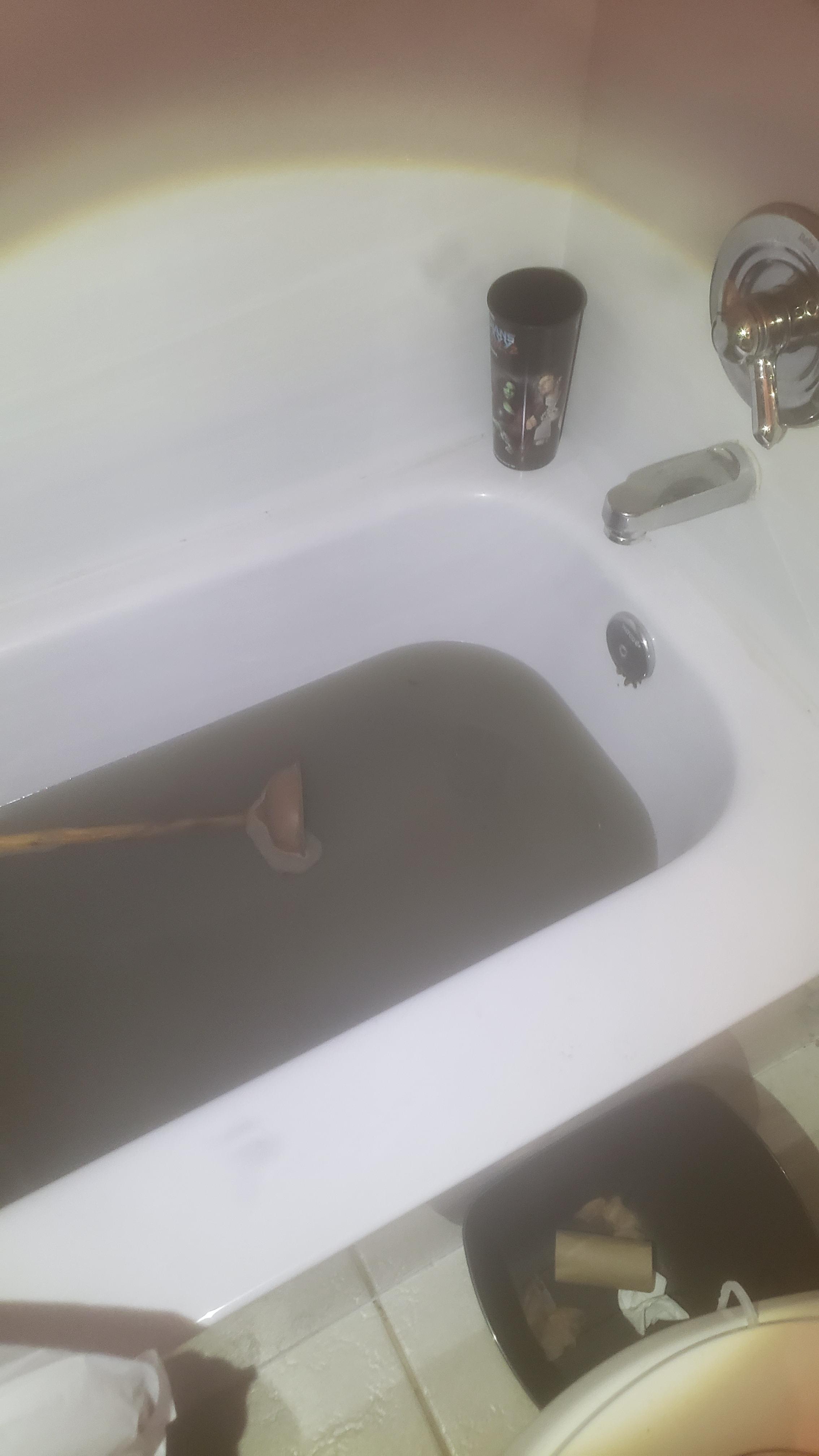Unpacking the Causes of Drainage in the Bathtub
Unpacking the Causes of Drainage in the Bathtub
Blog Article
We've uncovered this post on What to Do if Sewage Starts Coming Up Through Your Bathtub below on the internet and think it made sense to quickly share it with you here.

Sewage back-up in the bath tub can be an upsetting and unsanitary problem for any house owner. Not only is it inconvenient, yet it additionally poses significant health threats and shows underlying concerns with the plumbing system. Recognizing why sewer is showing up with the bath tub is essential for taking proper action to deal with the problem efficiently.
Introduction to the Concern
Comprehending the Trouble
When sewer draws back up into the bathtub, it's a clear indication of a problem with the water drainage system. The wastewater that needs to be streaming away from your home is instead locating its way back into your space, which can cause considerable damages and carcinogen.
Prospective Reasons
A number of factors can add to sewage back-up in the tub. From blockages in the sewage system line to problems with the plumbing infrastructure, recognizing the source is vital for finding an option.
Typical Reasons for Sewage Backup
Obstructions in the Sewer Line
Among the most typical root causes of sewage backup is a blockage in the drain line. This can happen due to the build-up of debris, grease, or international things in the pipes, protecting against appropriate circulation and causing sewage to back up into your tub.
Tree Origin Intrusion
Tree roots looking for dampness and nutrients can infiltrate drain lines via tiny cracks or joints. In time, these origins can expand and expand, creating considerable damage to the pipelines and leading to sewer backup problems.
Aging Facilities
Older homes might have dated plumbing systems that are more vulnerable to rust, splits, and deterioration. As pipelines age, they come to be more prone to leaks and blockages, raising the likelihood of sewage backup events.
Heavy Rainfall or Flooding
During durations of heavy rainfall or flooding, the drain system might come to be overloaded with excess water, creating back-ups and overflows. This can result in sewer supporting right into bath tubs and various other fixtures inside the home.
Health Dangers Connected With Sewage Back-up
Contamination of Supply Of Water
Sewage backup can infect the water system in your home, posturing a serious wellness danger to you and your household. Exposure to polluted water can lead to gastrointestinal concerns, skin infections, and other illnesses.
Spread of Condition
Sewer consists of damaging microorganisms, viruses, and parasites that can create a variety of illness, including hepatitis, cholera, and gastroenteritis. Entering into contact with sewage or infected surfaces places you in danger of infection.
Mold Development
Wetness from sewage backup can produce perfect problems for mold growth in your house. Mold and mildew spores can intensify respiratory issues and cause allergic reactions in delicate people, making timely cleaning essential.
Indications of Sewage Back-up
Foul Odors
Unpleasant odors originating from drains or fixtures, specifically in the restroom, may show sewage backup concerns. These smells are usually strong and persistent, signaling an issue that calls for prompt focus.
Slow Draining Fixtures
Bathtubs, sinks, and toilets that drain pipes slowly or not in any way could be experiencing sewer backup. If several fixtures are affected concurrently, it's most likely that the issue originates from a typical factor, such as the main drain line.
Gurgling Noises
Odd gurgling or gurgling noises originating from drains pipes when water is running elsewhere in the house are indicative of air caught in the plumbing system. This air accumulation can arise from sewage backup and must be explored promptly.
Immediate Actions to Take
Turning Off Water
In case of sewage backup, it's necessary to turn off the supply of water to prevent more contamination and damages. Find the primary water shutoff valve in your home and shut it off up until the issue can be dealt with.
Getting In Touch With an Expert Plumber
Handling sewer back-up is not a do it yourself work. Call a licensed plumber with experience in managing sewage-related concerns to evaluate the circumstance and perform needed repair services or cleanings.
Staying Clear Of Contact with Contaminated Water
Till the sewer back-up is dealt with, avoid contact with infected water to stop the spread of germs and virus. Use protective equipment if you should remain in the affected area and clean your hands thoroughly later.
Preventive Measures
Normal Upkeep of Sewer Lines
Arrange normal inspections and upkeep of your sewer lines to determine and resolve potential issues before they rise into major issues. This can include cleaning debris, checking for tree origin breach, and fixing any kind of damaged pipes.
Mounting Bayou Shutoffs
Consider installing bayou valves in your plumbing system to prevent sewage from flowing back into your home during periods of heavy rainfall or flooding. These shutoffs immediately close when water draws back up, securing your residential property from contamination.
Appropriate Disposal of House Waste
Avoid flushing anything other than toilet tissue and human waste down the toilet to stop obstructions and clogs in the drain line. Dispose of oil, oil, and other home chemicals effectively to reduce the danger of plumbing issues.
Tidying up After Sewer Back-up
Disinfection Procedures
Completely sanitize and disinfect affected areas after sewer back-up to eliminate damaging bacteria and protect against mold growth. Usage proper cleaning products and safety gear to guarantee secure and efficient cleanup.
Repair of Affected Locations
Repair any kind of damage to flooring, wall surfaces, or fixtures caused by sewer backup. Depending upon the degree of the damage, you might need to replace carpets, drywall, or other materials to recover your home to its pre-loss condition.
Sewage Coming Up Through the Bathtub?
Understanding the Plumbing System:
To understand why sewage is coming up through your bathtub, it is essential to have a basic understanding of the plumbing system. The plumbing system is a complex network of pipes, valves, fixtures, and drains that work together to provide clean water to your home and remove waste and sewage. The system consists of two parts: the supply system and the drainage system.
The supply system brings clean water to your home, while the drainage system removes wastewater from your sinks, toilets, showers, and bathtubs. The drainage system is connected to the main sewer line, which carries the wastewater to the municipal sewage treatment plant or septic tank.
Causes of Sewage Coming Up Through the Bathtub:
Sewage coming up through the bathtub can be caused by various factors. Some of the most common causes are:
Clogged Drain Pipes:
One of the most common reasons for sewage coming up through the bathtub is a clogged drain pipe. Over time, debris, hair, soap scum, and other foreign objects can accumulate in the drain pipes, leading to a blockage. This can cause the wastewater to back up and come out of the bathtub.
Main Sewer Line Blockage:
Another reason for sewage coming up through the bathtub is a blockage in the main sewer line. The main sewer line connects your home’s drainage system to the municipal sewer system. If the main sewer line gets clogged due to tree roots, grease buildup, or other obstructions, it can cause sewage to back up into your home’s plumbing fixtures, including the bathtub.
Sewage Backup:
Sewage backup is another common cause of sewage coming up through the bathtub. Sewage backup occurs when there is a problem with the municipal sewer system, such as heavy rainfall, flooding, or a malfunctioning pump. When this happens, sewage can flow back into your home’s drainage system and cause sewage backup in your plumbing fixtures, including the bathtub.
Broken or Damaged Pipes:
Finally, broken or damaged pipes can also cause sewage to come up through the bathtub. Over time, pipes can deteriorate due to age, corrosion, or external factors such as shifting soil. When pipes break or crack, wastewater can leak out and cause sewage backup in your plumbing fixtures.
Signs of Sewage Coming Up Through the Bathtub:
Some of the signs that sewage is coming up through your bathtub include:
Foul odor: If you notice a strong, unpleasant odor coming from your bathtub drain, it could be a sign of sewage backup. The smell is caused by the buildup of organic waste in the pipes. Slow drainage: If your bathtub drains slowly or not at all, it could be a sign of a clogged drain pipe or a more severe problem with the main sewer line. Gurgling sounds: If you hear gurgling sounds coming from your bathtub drain or other plumbing fixtures, it could indicate that air is trapped in the pipes due to a blockage. Prevention Measures:
The best way to prevent sewage from coming up through the bathtub is to take preventative measures. Here are some practical tips:
Regular Drain Cleaning:
Regular drain cleaning can help prevent clogs and keep your pipes in good condition. You can use a plunger, drain snake, or enzymatic drain cleaner to remove any buildup of hair, soap scum, or other debris in your bathtub drain.
Proper Waste Disposal:
Improper waste disposal can also contribute to sewage backup. Avoid flushing non-biodegradable items, such as paper towels, feminine hygiene products, or wipes down the toilet. Also, be mindful of what you pour down the drain, such as grease, oil, or coffee grounds, as they can cause clogs.
Professional Plumbing Maintenance:
Regular plumbing maintenance can help prevent plumbing emergencies, such as sewage backup. A professional plumber can inspect your pipes, identify any potential issues, and perform preventative measures, such as hydro jetting, to clean your pipes.
Hydro Jetting:
Hydro jetting is a powerful method that uses high-pressure water to clean the pipes thoroughly. It can remove even the most stubborn clogs and prevent future blockages.

As a devoted reader on Why sewage is coming up through your bathtub, I imagined sharing that piece of content was appropriate. Enjoyed reading our article? Please quickly share it. Help other people find it. Thank you so much for your time invested reading it.
Visit My Website
Report this page